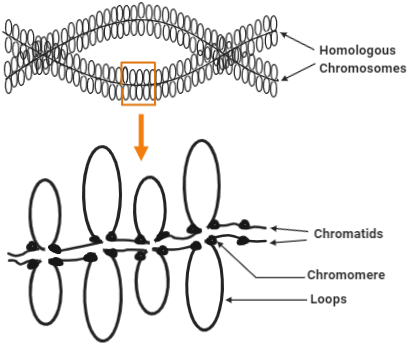
Draw the diagram of Lampbrush chromosomes and label its part.
Answer
469.2k+ views
Hint: Chromosomes are highly organised DNA molecules which carry the genetic information from one generation to the other. Some chromosomes show a peculiar change in their structure and size. They appear bigger than normal. One such chromosome type is Lampbrush chromosome. These look like lamp cleaning brushes because of their extraordinary structure.
Complete answer:

Lampbrush chromosomes were first spotted in the oocytes of an amphibian, Salamander by Walther Flemming in 1882. He noticed that in the prolonged Prophase (diplotene stage) of the first meiotic division some chromosomes appeared exceptionally big.
Lampbrush chromosomes are bivalents that have both maternal and paternal chromosomes. Thus there are 4 chromatids two each from the two conjugating homologues held together by chiasmata. These highly condensed chromatin threads from the chromosomal axis that have an array of bead-like chromomeres. From each chromomeres two lateral loops of DNA project out. These lateral loops are formed as a result of acute RNA synthesis.
The lateral loops are absent on the centromere. These chromosomes are transcriptionally active and can be observed even under a light microscope.
Lampbrush chromosomes are present in the nucleus of Acetabularia, a giant single-celled alga, in the oocytes of both vertebrates and invertebrates and also spermatocytes of many species.
Additional information:
So, Ruckert in 1892 coined the term Lampbrush chromosomes for these big chromosomes.
In oocytes of a Salamander, there are about ten thousand loops present in each haploid chromosome.
Note: Lampbrush chromosomes are used in high-resolution mapping of chromosomes (DNA sequences). They are helpful in understanding the gene expression and transcriptional changes due to the chromosomes. They can be useful resources for hybridization analysis also.
Complete answer:

Lampbrush chromosomes were first spotted in the oocytes of an amphibian, Salamander by Walther Flemming in 1882. He noticed that in the prolonged Prophase (diplotene stage) of the first meiotic division some chromosomes appeared exceptionally big.
Lampbrush chromosomes are bivalents that have both maternal and paternal chromosomes. Thus there are 4 chromatids two each from the two conjugating homologues held together by chiasmata. These highly condensed chromatin threads from the chromosomal axis that have an array of bead-like chromomeres. From each chromomeres two lateral loops of DNA project out. These lateral loops are formed as a result of acute RNA synthesis.
The lateral loops are absent on the centromere. These chromosomes are transcriptionally active and can be observed even under a light microscope.
Lampbrush chromosomes are present in the nucleus of Acetabularia, a giant single-celled alga, in the oocytes of both vertebrates and invertebrates and also spermatocytes of many species.
Additional information:
So, Ruckert in 1892 coined the term Lampbrush chromosomes for these big chromosomes.
In oocytes of a Salamander, there are about ten thousand loops present in each haploid chromosome.
Note: Lampbrush chromosomes are used in high-resolution mapping of chromosomes (DNA sequences). They are helpful in understanding the gene expression and transcriptional changes due to the chromosomes. They can be useful resources for hybridization analysis also.
Recently Updated Pages
Master Class 12 Economics: Engaging Questions & Answers for Success

Master Class 12 Maths: Engaging Questions & Answers for Success

Master Class 12 Biology: Engaging Questions & Answers for Success

Master Class 12 Physics: Engaging Questions & Answers for Success

Master Class 12 Business Studies: Engaging Questions & Answers for Success

Master Class 12 English: Engaging Questions & Answers for Success

Trending doubts
Give simple chemical tests to distinguish between the class 12 chemistry CBSE

Define peptide linkage class 12 chemistry CBSE

Draw a labelled sketch of the human eye class 12 physics CBSE

Differentiate between lanthanoids and actinoids class 12 chemistry CBSE

Phenol on treatment with conc HNO3 gives A Picric acid class 12 chemistry CBSE

Differentiate between homogeneous and heterogeneous class 12 chemistry CBSE




